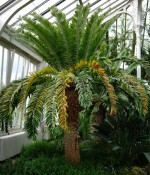 A cycad tree of the ancient species Encephalartos woodii was brought from Africa to the Kew Gardens in London in 1895. Since then, it has been cloned, but cannot reproduce in the normal way, because it is male -and it may be the only natural example of its species left in the world.
A cycad tree of the ancient species Encephalartos woodii was brought from Africa to the Kew Gardens in London in 1895. Since then, it has been cloned, but cannot reproduce in the normal way, because it is male -and it may be the only natural example of its species left in the world.Researchers have wandered the Ngoya forest and other woods of Africa, looking for an E. woodii that could pair with the one in London. They haven’t found a single other specimen. They’re still searching. Unless a female exists somewhere, E. woodii will never mate with one of its own. It can be cloned. It can have the occasional fling with a closely related species. Hybrid cycads are sold at plant stores, but those plants aren’t the real deal. The tree that sits in London can’t produce a true offspring. It sits there, the last in its long line, waiting for a companion that may no longer exist.The tree produced a cone in 2004 for the first time ever, which is the signal for reproduction, but there was no female for it to pollinate.
“Surely this is the most solitary organism in the world,” writes biologist Richard Fortey, “growing older, alone, and fated to have no successors. Nobody knows how long it will live.”
This Cycad at Kew Gardens is even older
World's Oldest Potted Plant
 It took three months of planning, a crane, and nine gardeners to transfer a palm tree called a cycad to a new pot. The operation at Kew Gardens in London was difficult and delicate because the tree is considered to be the oldest potted plant in the world.
It took three months of planning, a crane, and nine gardeners to transfer a palm tree called a cycad to a new pot. The operation at Kew Gardens in London was difficult and delicate because the tree is considered to be the oldest potted plant in the world.The ancient cycad was collected in the early 1770s from the Eastern Cape in South Africa by Kew’s first plant hunter, Frances Masson.The repotting procedure was successful.
It was one of 500 species gathered for the botanical gardens during Captain Cook’s second voyage around the globe.
For the last 160 years, the tree has been housed in Kew’s Palm House, where its nobbly trunk has grown outwards and upwards at an inch a year.
It now stretches to 14ft 5 inches and because it is growing at an angle, is propped up by stilts.

No comments:
Post a Comment